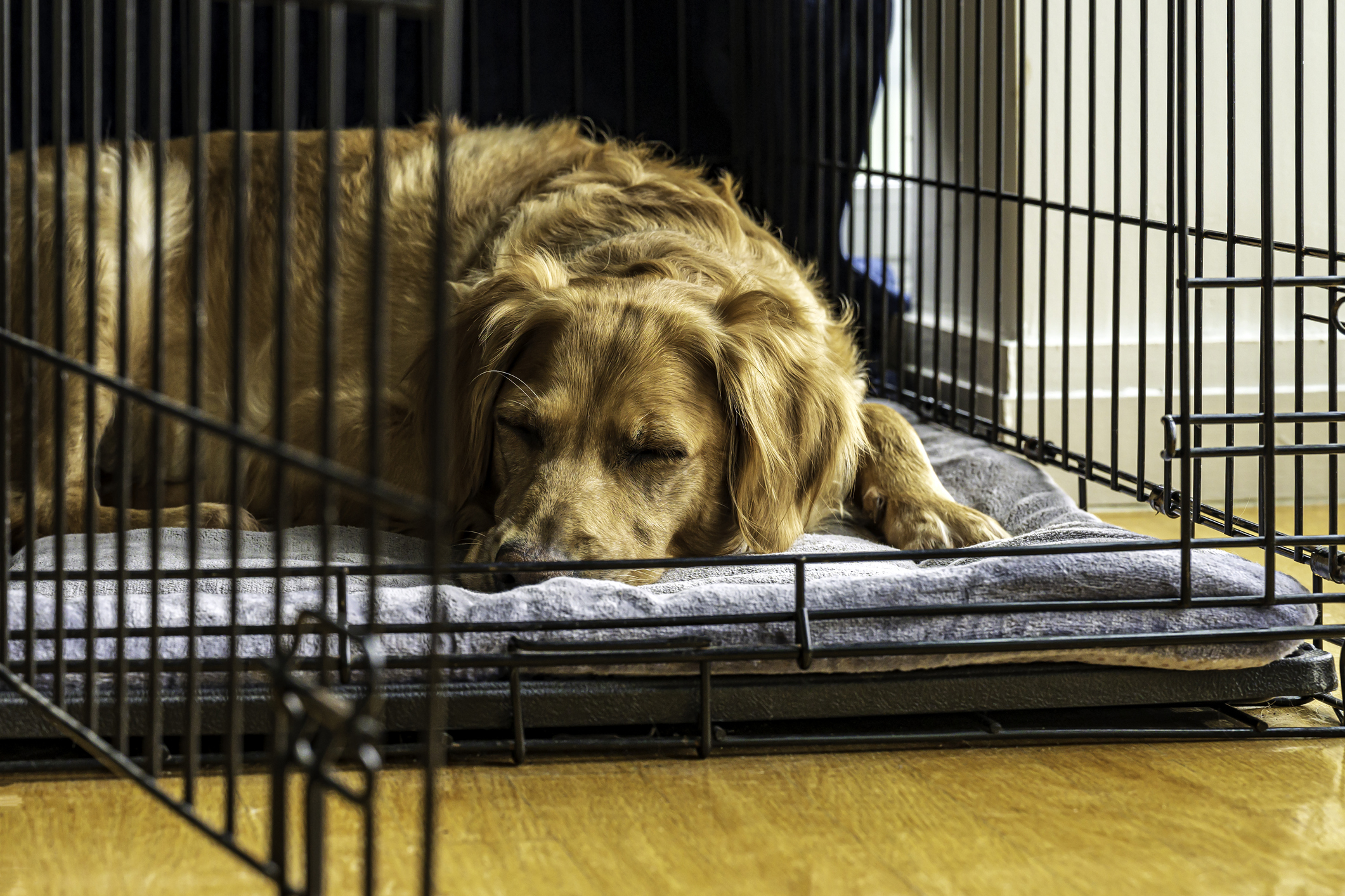Trainers hear this every day: “I don’t want to lock my dog in a cage,“ or “I grew up with dogs, we never crated them and it was totally fine, so I don’t think it’s necessary.” These statements show a fundamental misunderstanding of how a crate should be used – and why it’s so important.
Crates should be kind
Before we get into what crates are used for, we should clarify a common misconception: crates should not be a punishment. Through proper training and use, the crate should become a calming, joyful place for your dog. It should be a sanctuary, a place where they have tons of good memories, where nothing bad happens, where they can feel safe, secure, at ease.
To that end, you can’t just put a dog into a crate. While the dark, quiet, secluded space does tap into a puppy’s ‘den instinct,’ you still need to ease them into it. Shoving a puppy into a crate – a new environment where they could feel trapped and panic – turns it into a negative experience.
Instead, you need to pursue careful, appropriate ‘crate training.’ We’ll link to more details below, but in brief it has a few basic elements:
- Make it positive. The crate should be a place where some amazing things happen. Your dog should get some of the best treats there, especially long-lasting ones like stuffed chewtoys. Note however while the crate should be a positive space, it should also be a calm one: it’s a place you want to help your dog relax quietly (as we’ll see in a second). That means you should stick to food rewards, not playing with your dog. It’s a great idea to put some of her favorite solo-play chewtoys in there, but no tug or cooperative toys.
- Go SLOW! Don’t just put your puppy in the crate. First, let her explore the crate from the outside, giving her great treats as rewards whenever she gets close to it or investigates it. Eventually, tempt her near the door with some treats placed there, and eventually tempt her inside with treats. Even then, don’t shut the door: reward her (with the door open) for staying in the crate for longer and longer periods, and then eventually start partially – and eventually fully – closing the door, all while rewarding her. It’s important that she only ever has positive experiences with the crate, and doesn’t get fearful or panic.
- Get the setup right. The crate should be a sanctuary. That means it should be covered on most sides, in a quiet area of the house that your dog has access to, and neither too big nor too small. If you’re watching TV loudly or your dog is stressed by some visitors, they should be able to retreat there.
- Put it on cue. Once she’s going inside on her own, you can start pairing the Crate with a cue, like “Go Crate.” If you’ve done a good job on reinforcement, she’ll rush over to the crate whenever you give the cue, to get her well-deserved reward!
- Use it properly. If you use the crate as a punishment, it will become one. It’s perfectly OK to send your dog to the crate when she’s over-excited to help her calm down, but it should never be done in anger or as a response to something bad they have done. For example, if they’re over-excited and jumping on guests, don’t yell at them and send them to the crate. Instead, refocus them with a couple simple tricks, like Sit and Paw, give them a strong reward for those, and then send them to the crate, giving them a well-stuffed chewtoy for occupation. That will help them calm themselves, redirecting their excitement into chewing. Depending heavily on the dog and the situation, you may want to keep the crate in eyesight so that they get less FOMO. Once they’re calm, again depending on the dog, you could potentially let them out.
- Use it regularly. After you’ve crate-trained your dog, you might not, depending on your lifestyle circumstances, find regular need for it (see below). Even if you don’t, make sure to crate your dog at least once a week – always with lots of positive reinforcement. As you’ll see shortly, it’s important that your dog remains comfortable being crated.
To learn more about crate training, see the RCO Primer chapter on crate training, or talk to a professional trainer (see below).
Why crates matter
So why go through all that trouble, making your dog love being crated? Because: crates are an essential tool for helping your dog live safely and happily in a human-centric world.
Here are just a few important scenarios where crating and crate training pay off:
- Help them calm down when they’re over-excited. Sometimes puppies and even adult dogs get too excited and can’t control themselves. Maybe guests are visiting, or your puppy is over-tired, or they have a lot of pent-up energy. As outlined above, the crate should be a joyful but calming space. Sending them there can help them calm themselves, especially if you combine it with a great chewtoy for occupational therapy to help redirect that energy. As outlined above however (see ‘Use it properly’ above), make sure not to use the crate as a punishment!
- Help with separation anxiety. All dogs suffer from ‘separation anxiety’ – they get nervous when left alone. That not only causes them distress, it can also lead to destructive behaviors, like chewing furniture, barking incessantly, or urinating in the home. To avoid that you must do separation anxiety training with your puppy, but crates can also help with that experience. For some dogs, crating (after thorough, positive crate training) can help them feel more secure and safe when you’re gone, instead of anxiously pacing around the house checking windows.
- Help with nighttime sleep. Puppies in particular can struggle to get back to sleep when they wake up at night. The crate, when properly trained, should help them stay relaxed and go back down.
- Help with potty training. As outlined in the RCO Primer and Ian Dunbar’s Before & After Getting your Puppy, part of potty training is keeping your puppy’s ‘circle of freedom’ appropriately-sized, expanding it gradually over time. You generally use a pen or barricade for that, but a crate should be a part of ‘their space,’ providing both a place for them to nap quietly and a place for you to reduce the likelihood of accidents (dogs instinctively try not to go potty in their ‘den’) if you need to step out of the room for a few minutes.
- Help them when you travel. What if you need to board your dog, or leave them with friends? Even if you’re not crating your dog regularly at home, others may want or need to. Your dog will already be stressed and anxious about being in an unfamiliar place with unfamiliar people: crate-training can help make the crate a source of comfort for her in that situation, as opposed to yet another new and unfamiliar source of stress.
- Help when you go to the vet. The vet is another stressful situation: your dog may be in pain, they’re being poked and prodded, there’s lots of fear pheromones in the air. If she needs to stay overnight, she’ll have to be crated. Again, crate training makes all the difference here.
As you can see, effective crate-training and use of crates can help keep your dog safe and calm in a wide range of situations!
Want to learn more?
Check out the Crate Training chapter in the RCO Primer – or, even better, talk to a professional trainer! After all, every puppy or adult dog owner should, at bare minimum, be taking at least one 6-12 week ‘basic obedience’ course!




